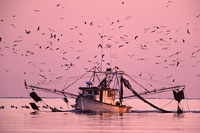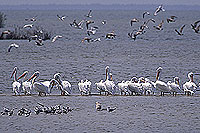|
History Animals & Plants Natural Communities Coastal Dry Uplands Upland Mesic Freshwater Marshes Forested Wetlands Fresh Water Estuaries |
Natural Communities and Habitats:
Coasts and estuaries: Apalachee and Apalachicola Bays
 Shrimp and many species of fish require estuaries at some point in their life cycles. (photo by Karla Brandt) |
The two major estuaries are Apalachee Bay and Apalachicola Bay. Although neighbors, they are very different. Apalachee Bay's coast is nearly solid salt marsh, while Apalachicola Bay wears a necklace of narrow, sandy strips (Dog, St George, and St. Vincent Islands and St. Joseph Peninsula) which boast postcard-perfect beaches. Why are these two bays so different?
The crucial reason is the difference in wave energy. Along the shore of Apalachee Bay, the waves that reach the coast don't have enough power to bring in sand to create and maintain beaches. Apalachee Bay is classified as an open bay type of
estuary, where the water is shallow for a long way out from the shore. Winds and waves are weak, so there's not enough sediment brought in by rivers and waves to make islands. Marsh grasses - black needlerush (Juncus roemarianus) and smooth cordgrass (Spartina alterniflora) - are left in peace to grow, die, and form the basis for one of the world's most productive food chains—the salt marsh.
West of Ochlockonee Bay, waves are stronger - strong enough not only to carry sands but also to shape them into islands and spits. Offshore waters are shallow, but they are deeper much closer to shore than in Apalachee Bay. Apalachicola Bay is a type of estuary called a closed embayment, where waves have enough oomph to sling sand into piles that build up into barrier islands. The Apalachicola River's huge drainage basin also supplies sediments to the bay, and the river's enormous contribution of fresh water carries these sediments into the estuary.
Because open bays are directly connected to the open waters of the Gulf of Mexico, they are generally a little saltier than their sheltered cousins, the closed embayments. Both still qualify as brackish, however.
Salinity
| Type of Water | Salt content, Parts per thousand |
| Fresh | Less than 0.5 |
| Brackish (estuarine) | 0.5 to 30 |
| Salt (coastal ocean) | 30-37 |
Estuaries are edged with beaches, salt marshes, or tidal flats (see separate accounts of those communities). In and under the water of the ARROW region's estuaries, you can find:
 Pelicans, terns, seagulls, and many species of shorebirds are links in the food chain in Apalachicola Bay. (photo by Karla Brandt) |
Seagrass beds get their name from a half-dozen species of plants that flower just like land plants do; they are not related to grasses that grow on land. Hundreds of species of algae grow on the leaves of these plants, which would smother them if it weren't for the animals that graze on the algae, such as pinfish. The grazers, in turn, are eaten by larger fish and invertebrates. The young of many fish and invertebrate species rely on seagrasses for food and shelter. Without seagrass beds, we would have no scallops or shrimp, and our fisheries would be much poorer. Sea turtles savor turtlegrass, and manatees munch on manatee grass, which are two of the most widespread seagrasses in the ARROW area. Because seagrasses,
like other plants, depend on sunlight, they cannot grow where the water is muddy, and they can't grow in very deep water, either.
Note: The content of the website has not been updated since 2005. The site remains online for it's value as legacy content and is unlikely to be updated.